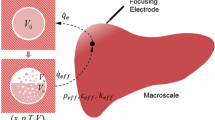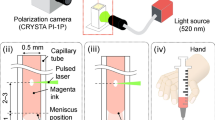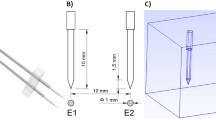Abstract
Radiofrequency-assisted methods have been used in hepatectomy—the resection process of removing liver tissue which encapsulates the tumor from the liver organ. A prototype was built to enable smooth surgical transition between radiofrequency ablation and liver resection. There is a lack of literature on mechanical properties of radiofrequency-ablated liver tissue and the tool–tissue interaction during cutting. This led to our study on coagulated tissue mechanical properties and modeling of its dynamic interaction with a scalpel blade. A novel mechanical model was proposed to mimic the mechanical behavior of radiofrequency-ablated liver tissue. The model is able to account for the viscoelastic behavior of the ablated tissue in both compression and relaxation tests. Experiments were performed to validate the proposed model. In addition, a knife blade–tissue interaction model is proposed to demonstrate the potential of integrating the proposed model for application in device design.








Similar content being viewed by others
References
Jiao LR, Navarra G, Weber J-C, Havlic R, Nicholls JP, Habib NA (2006) Radio-frequency assisted liver resection: the Habib’s technique. Adv Exp Med Biol 574:31–37
Chang KY, Hlaing WW, Huang WH, Chui CK (2010) Integrated ablation and division device for liver resection. Off J HPB 13(3):158–160
Fung YC (1993) Biomechanics: mechanical properties of living tissues, 2nd edn. Springer, New York
Buchtel F, Kaiser E (1951) The rheology of the cross striated muscle fibre with particular reference to isotonic conditions. Biol. Medd. Det Kongelige Danske Videnskabernes Selskab, Copenhagen, Denmark
Viidik A (1966) Biomechanics and functional adaptation of tendons and joint ligaments. In: Evans FG (ed) Studies on the anatomy and function of bone and joints. Springer, New York, pp 17–38
Terzopoulos D, Fleiseher K (1988) Modeling inelastic deformation: viscoelasticity, plasticity, fracture, in SIGGRAPH ‘88. ACM, Atlanta
Schwartz JM (2005) Modeling liver tissue properties using a non-linear visco-elastic model for surgery simulation. Med Image Anal 9:103–112
Hauth M et al (2003) Soft tissue simulation based on measured data. In: Medical Image Computing and Computer-Assisted Intervention. Springer, Berlin, pp 262–270
Sinkus R (2007) MR-elastography ecole supérieure de physique et de chimie industrielles de la Ville de Paris
Huwart L et al (2006) Liver fibrosis: non-invasive assessment with MR elastography. NMR Biomed 19:173–179
Rentschler ME et al (2006) Modeling, analysis, and experimental study of in vivo wheeled robotic mobility. IEEE Trans Robot 22(2)
Chanthasopeephan T, Desai JP, Lau AC (2003) Measuring forces in liver cutting: new equipment and experimental results. Ann Biomed Eng 31(11):1372–1382
Chanthasopeephan T, Desai JP, Lau AC (2004) Study of soft tissue cutting forces and cutting speeds. Stud Health Technol Inf 98:56–62
Chanthasopeephan T, Desai JP, Lau AC (2007) Modeling soft-tissue deformation prior to cutting for surgical simulation: finite element analysis and study of cutting parameters. IEEE Trans Biomed Eng 54(3):349–359
Chui CK et al (2004) Combined compression and elongation experiments and non-linear modelling of liver tissue for surgical simulation. Med Biol Eng Comput 42:787–798
Chui CK (2004) Mechanical properties, constitutive equations, integrative computational model of liver and their applications in computer aided surgery. PhD thesis, The University of Tokyo, Japan
Huang WH, Chui CK, Kobayashi E, Teoh SH, Chang SKY (2011) Multi-scale model for investigating the electrical properties and mechanical properties of liver tissue undergoing ablation. Int J Comput Assist Radiol Surg 6(5):601–607
Delingette H (1998) Towards realistic soft tissue modeling in medical simulation. In: IEEE proceedings: special issue on surgery simulation
Ko SC, Lee S, Hsueh CH (2003) Viscoelastic stress relaxation in film/substrate systems—Kelvin model. J Appl Phys 9(5):2453–2457
Basafa E, Farahmand F, Vossoughi G (2008) A non-linear mass-spring model for more realistic and efficient simulation of soft tissues surgery. In: Westwood JD et al (eds) Studies in health technology and informatics. IOS Press, Amsterdam, pp 23–25
Delingette H, Ayache N (2004) Soft tissue modeling for surgery simulation. In: Ciarlet PG (ed) Handbook of numerical analysis. Elsevier, Sophia-Antipolis, France
Leong F, Chui CK, Chang SK, Sakuma I, Poo AN (2008). Modeling and simulation of tissue/device interaction using standard viscoelastic model. In: IEEE international conference on systems, man and cybernetics
Acknowledgments
This work was supported in part by the JSPS-Singapore Research Project Grant (R-265-000-285-112 and R-265-000-285-646).
Author information
Authors and Affiliations
Corresponding author
Rights and permissions
About this article
Cite this article
Leong, F., Huang, WH. & Chui, CK. Modeling and analysis of coagulated liver tissue and its interaction with a scalpel blade. Med Biol Eng Comput 51, 687–695 (2013). https://doi.org/10.1007/s11517-013-1038-5
Received:
Accepted:
Published:
Issue Date:
DOI: https://doi.org/10.1007/s11517-013-1038-5




